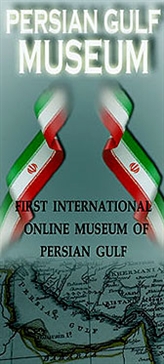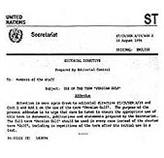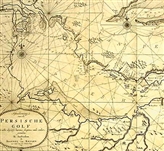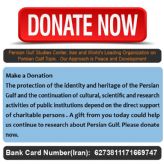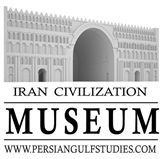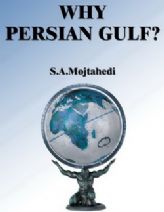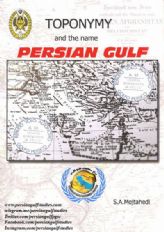Geography of Persian Gulf
Location
Translated by Roya Monajem
The Persian Gulf is located between 24° to 30° 30' N latitude and 48° to 56° 25' E longitude. The present Persian Gulf is a small part of a vast water space called Persian Sea in the remote past as it embraced the whole Makran (Oman) Sea and a part of the Indian Ocean up to the Indus River.
The present Persian Gulf is considered as a water channel extending from Makran (Oman) Sea with Iran, Saudi Arabia, Kuwait, Qatar, Emirates, Bahrain, Oman and Iraq around its shores. As Iran has the longest common water border with the Persian Gulf and has played the main role in the formation of the ancient civilization of this region, with Iranians controlling and ruling the Persian Gulf throughout the history, it is regarded the main inheritor of the region. The most prominent evidence for this claim is the very name of this water expanse recorded under the name of Iranians in the past three thousand years. The countries of the southern zone of the Persian Gulf such as Bahrain, Qatar, Kuwait, Emirates, etc are mostly some newly established small countries whose borders have been divided by the British colonialist will, thus lacking real historical and political legitimacy. That is why the control of this large strategic sea or gulf has always been in the hands of Iranian nation and government and it will remain so.
The Persian Gulf is connected to the Indian Ocean through Hormoz strait and Makran (Oman) sea from the east and from the west it receives Arvand River (formed by Euphrates and Tigris in Iraq and Karoon River in Iran) running in Khuzestan Province of Iran. The length of Persian Gulf from Hormoz Strait to the last point in the west is around 805Km.
Climate and Geographic longitude and latitude of Persian Gulf (Pars Sea)
Persian Gulf is the warmest water expanse known with dry semi-tropical climate. Its widest part reaches 180 miles and its depth is from 10-30m in the west to 93m which is its deepest point 15Km away from the Island, Big Tonb. The low depth of Persian Gulf constantly causes land to advance into the sea. Despite its highly salty water, there are 200 underground water springs flow on the floor of the Persian Gulf and 25 springs with palatable water on its shore all arising from Zagros or Pars Mountains in Iran. Arvand, Karoon, Dialeh, Zaab, Jaraahi, Mand, Daalaki and Minaab are the largest rivers pouring into Persian Gulf. In summers, the temperature sometimes rises up to 50 degrees centigrade an in winter to 3 degrees. Seaports Kish, Bandar Abbas, Khoramshahr, Dubai, Sharjeh, Abu Dhabi, Kuwait, Bahrain, Doha and Basra have turned Persian Gulf into an economic and tourist pole of the world. Persian Gulf is considered as an important and unique water expanse of the world from geopolitical, strategic, energy as well as history and civilization point of views. That is why it has always attracted the greedy eyes of exploiting countries of the world, which devoid of any significant role in the history of civilization, simply rule many countries of the world, particularly Arab countries of the Middle East by virtue of their illegitimate power. Recent archaeological discoveries on northern and southern shores of Persian Gulf prove that it is one of the most important water expanses of the world where the most primitive human settlements most probably emerged. There is no doubt that this area has been the cradle as well as exchange center of many civilizations such as Ilamite, Sumerian, Akkadian, Assyrian, Babylon, Madi, Parsi (Persian), Greek, Islamic and… For example, Jiroft region near the city of Kerman is well known as a city with more than six thousand years of recorded urban civilization with Pars Sea (Persian Gulf) regarded as its communication bridge.
At present Persian Gulf with an area of 237473Km squares (measured by Hydrographic Office of Iranian Geographic Organization, 2007) is the third largest gulf of the world after Mexico and Hudson Gulfs.
Despite the fact that Persian Gulf is connected to both Indian Ocean and Makran Sea, it is one of the shallowest seas of the world (with its deepest point reaching only 93m) comparable only to Baltic Sea and Hudson Gulf. While depth of Makran Sea reaches 3000m in certain places and that of Red Sea to more than 1000m, the average depth of Persian Gulf is 30m. This water expanse is the oldest known sea of the world. According to tectonic maps, Persian Gulf is one of the most seismically active foci of the world. The latest change in this gulf is its gradual rise, although very powerful earthquakes happen here every now and then too (Encyclopedia of Brittanica).
Geomorphology of Persian Gulf (Pars Sea)
1- Outlines of morphology of the region
Disregarding the water expanse of Persian Gulf, the region consists of two main morphologic units, mountain and plain. The main mountainous units of the region are in the north of Persian Gulf, that is in Iran with the two plains Lut and Kavir situated between them. Although other local and less significant mountainous units are found in other regions, but populated plains and vast deserts are among their main important features. We see the same type of lands in geographical plains of Iraq and Arabian peninsula too. The large desert “Rob-ol-khali and Nofuz” in Saudi Arabia make up a large part of these plains with their uniformity disrupted only by huge sand hills of Seyf-Borkhan and…
2- Morphology of coastlines
The longitudinal axis of Persian Gulf separates two completely distinct morphological regions whose features are strongly dependent on their tectonic state. West coasts of Persian Gulf make up a part of relatively stable lands of Saudi Arabia next to Precambrian part of this region. On the other hand, the unstable coastal regions of Iran make up the most important morphological units of the Persian Gulf. The shape of the coast particularly in this region is of longitudinal type running parallel to the neighboring heights. Along this line, the skirt of anticlines are sometimes aligned with the coastal region and sometimes the density of alluvial region produce a significant distance between the coast line and folded mountain range of Zagros (as seen in the coast of Bushehr).
Sandy shores make another dominant coastal type of this region. Due to low slope and considerable extent of ebb and flow, the coastal line has widened and can be seen as a distinct unit called Estrun. In certain parts of Estrun such as Port of Lengeh in Iran, mangrove trees (rhizophora mucronta) grown naturally create relatively thick forests. At high tides sand dunes disappear under water, but some always stay under water. Underwater ranges make it difficult for small boats to travel at low tides. Some stay out for ever giving rise to islands or peninsula. Islands such as Nakhilu and Om-olkaram in the south of Khurmoj are of sand type. Deltas are another coastal phenomena. One of the features of this phenomenon is the extraordinary shallow slope and their rapid development. The high density of alluvial regions of the two rivers Arvand and Karoon make the base of Abadan’s delta to increasingly enlarge. Enlargement of Mehran’s delta around the Port of Khamir is in such a way that makes it to appear to be joining to Qeshm Island. (Ala’-ee Ta’leqani 2004, p.357).
Alluvial geosynclines are among other phenomena of the Persian Gulf’s plains. Wherever Zagros’ folding approach the shoreline, the base of geosynclines progress to the water line. Here alluvial geosynclines have a significant role from the perspective of plains particularly those of Iran and Iraq (ibid, p.359)
